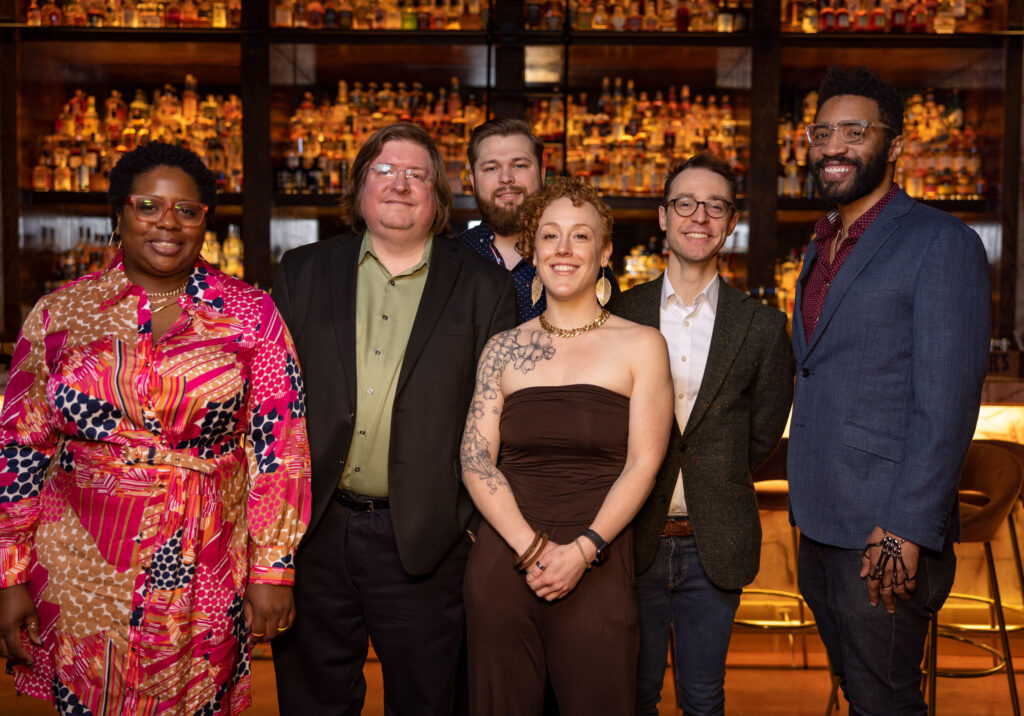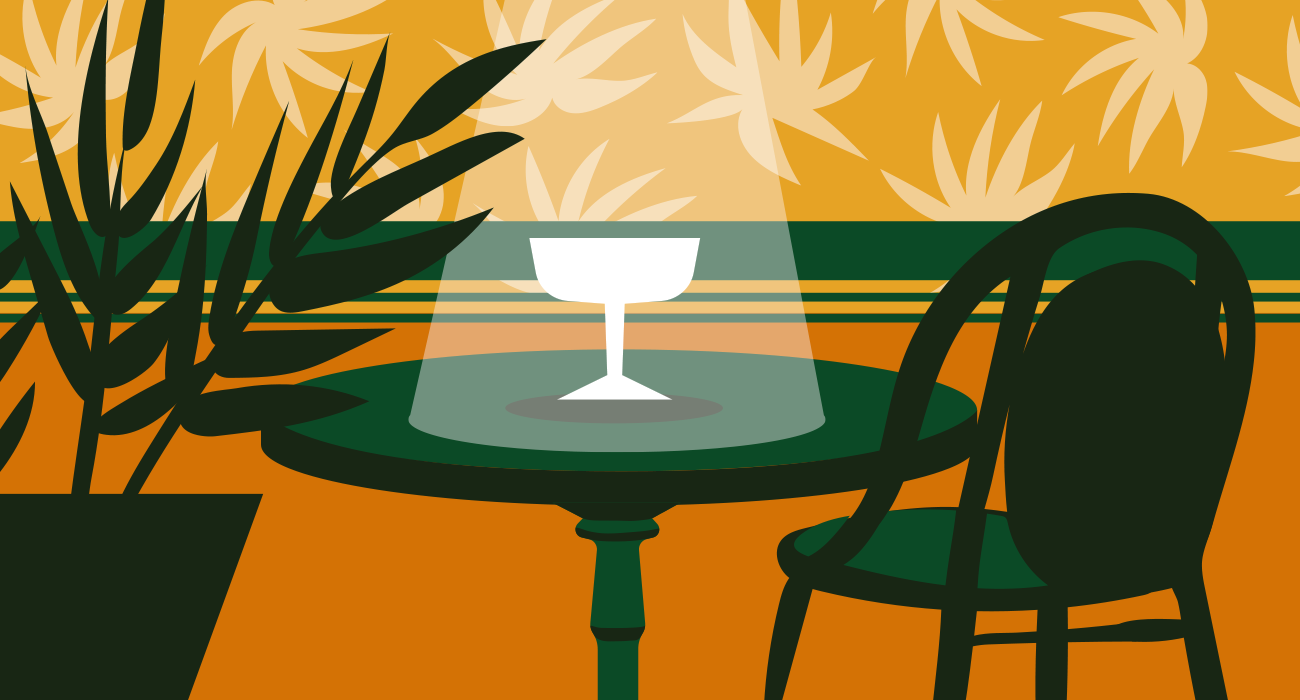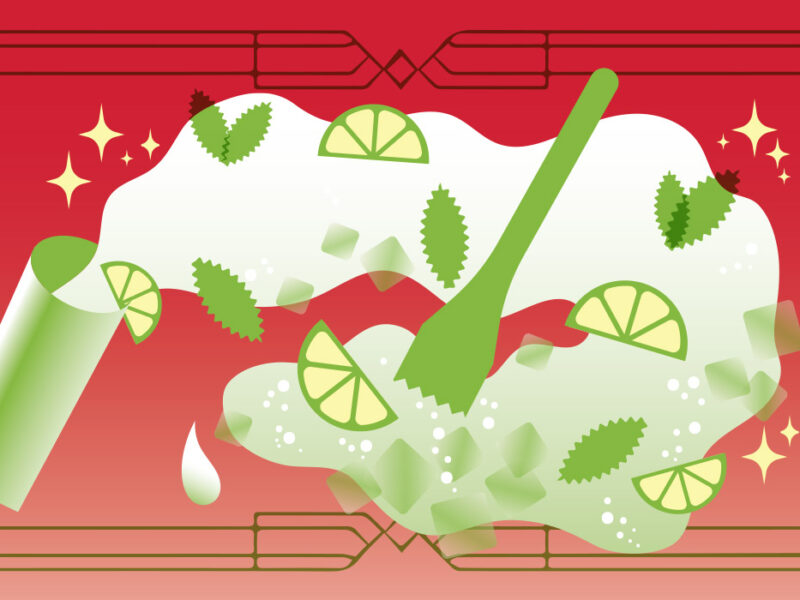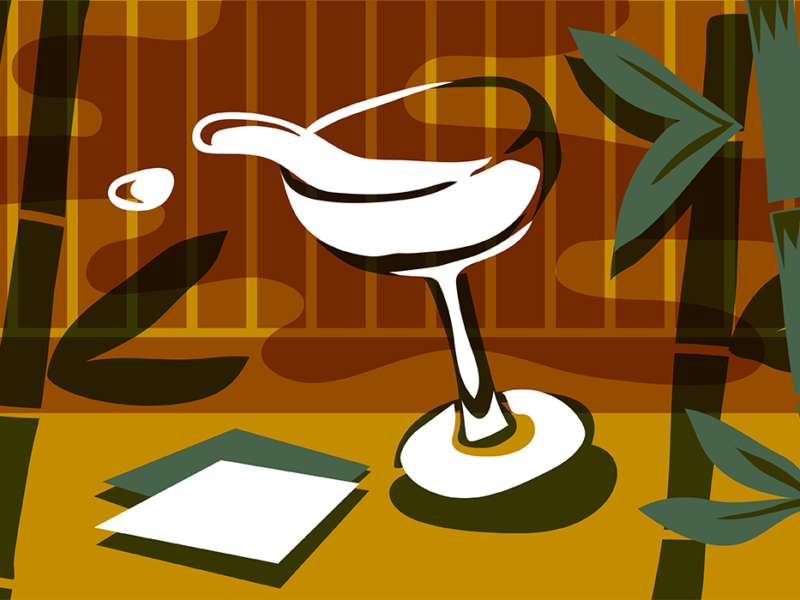For the return of the Daiquiri Dossier in 2022, we found ourselves once more in Chicago—where a glorious session had once been conducted at Three Dots and a Dash in 2019—because there was more to say. As always, we sought out some of the city’s top bar talent for their opinions (and recipes) on how to execute this compelling cocktail Cuba gave to the world.
On May 2, 2022, we assembled in the vast subterranean playground that is the Untitled Supper Club with a full itinerary of six Daiquiris and variations that would be flawlessly brought to life by the dynamic bar team of Jeremy Barrett, Davíd León Jr., and Zak McMahon.
The wrecking crew consisted of:
Ariel E. Neal, the hospitality industry community educator leading today’s cocktail culture one pour at a time.
Dan Smith, general manager of Queen Mary Tavern.
Nigal Vann, bartender at The Berkshire Room and founder of Vannity Cocktails.
Katie Vota, bartender at Andros Taverna and Certified Sake Specialist.
PJ Wagner, beverage manager of Untitled Supper Club.
Ben Schaffer moderated the discussion.
Supporting the creativity of the assemblage were our sponsors Bacardí, Denizen, Don Q, Luxardo, Mount Gay, Santa Teresa, and Wray and Nephew. We were proud to have them return for another round.
This transcript has been edited for length and clarity. — Ed.
Expectations
Ben: If you walk into a bar and order a Daiquiri, what are you expecting?
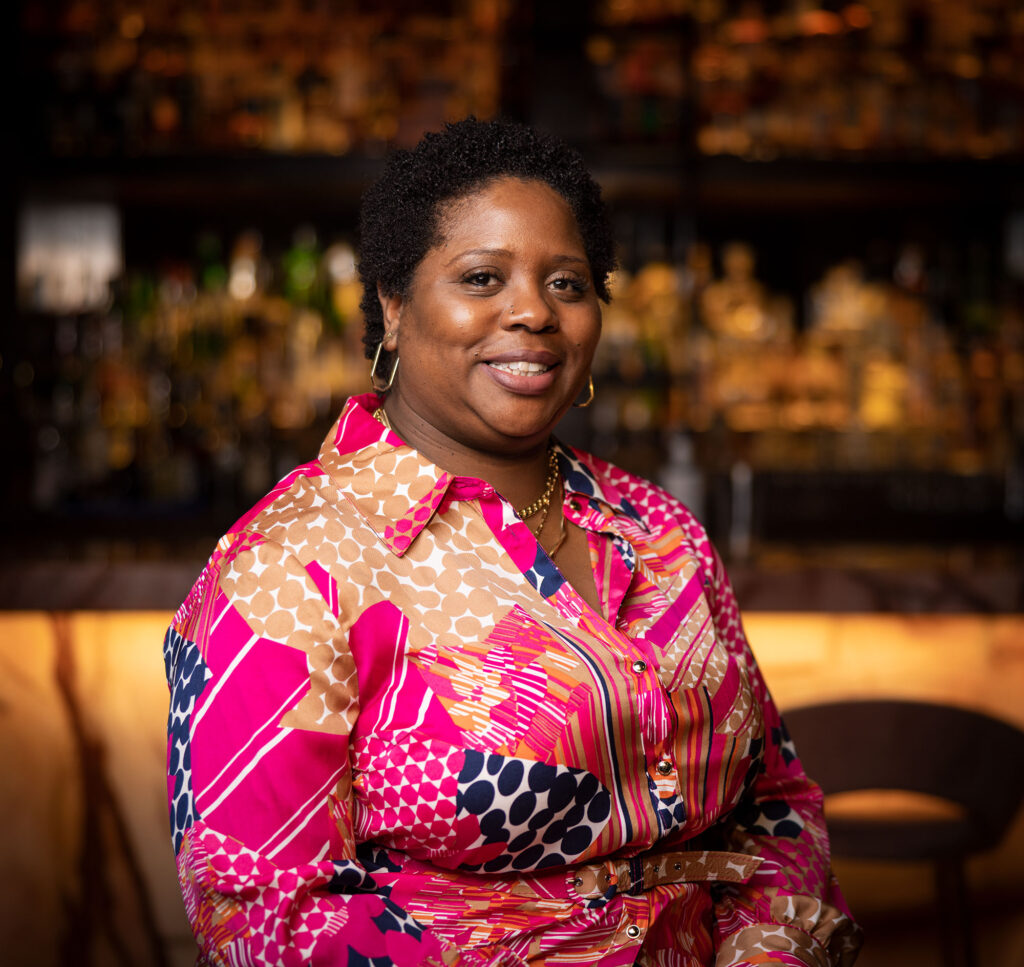
Ariel: I got this. So, for me, I’m looking for sweet, I’m looking for acid. I want a variation. I can do a classic Daiquiri, but I would love to know what other people think. And it is going to be served straight up. Please. No ice chips. Don’t put it in the blender. Don’t add no funny juice, just straight up.
Dan: If someone calls for a Daiquiri and doesn’t say anything further, to me that means rum and lime and sugar—specifically a white rum and a plain sugar that adds no or very little additional flavor. And, like Ariel, shaken and served straight up. There is ample room for other types of Daiquiri variations and cousins and other rum cocktails, but a Daiquiri is rum and lime and sugar, and that’s it.
PJ: If I’m at a bar and I order a Daiquiri, what I want above all else is balance. We all know that every day our lime juice is different—every lime you pick up is different. And as much as we’d love to believe otherwise, our sugars are never perfect either. So, I want to see that the drink is aerated, that it’s chilled, that it’s made in proportions that make sense for the ingredients used, whatever those happen to be. Every rum on the planet is different, which makes it interesting. I want to see that you care about the balance and that you’re serving it to me in a reasonable amount of time. It’s a Daiquiri, right? We’re not saving the world with this, but we are maybe presenting someone their first, best cocktail.
Nigal: I have to agree with all that. When ordering a Daiquiri, I want to see a classic without any razzle-dazzle. The balance is important to me. The textures are important to me. I want to taste the rum—that’s probably the most important part. Especially if I’m calling for a specific rum. I feel that too many Daiquiris are too sweet. I hate to be that guy that’s like, “I want a Daiquiri, but not too sweet.” So I test the parts in the first, and then the next time I’ll say, “Back up on the sweetness on that one.”
Katie: I think one of the things that I gravitate towards for the Daiquiri is that it is a showcase for rums with different flavor expressions. If I see a rum on the bar that I’m not familiar with, I’ll call the Daiquiri with it because I want to see what it tastes like.
Ben: People often say the Daiquiri is a bartender’s drink, that bartenders use it to gauge the prowess of other bartenders, to calibrate what’s going on in a new bar. Katie, can the Daiquiri be a way to see what bartenders are up to, what they’re interested in?
Katie: Yes. I have friends who work a bar who say, “I have these two rums. I’m going to put them in the same Daiquiri.” I’m like, “Okay, let’s do it.” It’s showing their ingenuity again. When you’re splitting rums, you’re looking at the balance, the texture of the cocktail, and the technique of the bartender.

PJ: I think my favorite comparison is looking at the Daiquiri the way the chef looks at an omelet. It’s the interview cocktail. If you can’t make a Daiquiri, then I don’t trust anything else on your menu, because balance is the most important thing. Rum, sugar, and lime are easy to balance. Every bartender touches rum, sugar, and lime every shift. If you can’t balance the three easiest things in your bar that you use every single day, I can’t expect more difficult and challenging ingredients to be balanced as well. So, if you can’t make a Daiquiri, you can’t make an omelet.
Ben: The last time we did a Daiquiri event in Chicago was 2019, when we had Toby Maloney—or is it Sir Toby Maloney, is that official yet? But he was on our panel, of course, and he said that the Daiquiri is three ingredients and the truth. I guess when he says the truth, he means ice. But I think that resonates. As has been said today, the Daiquiri is spare, it shows what’s up, but it also gives us the opportunity to tweak it in different ways that show other things.
Ariel: Absolutely. You can swap out your acids. I like swapping out passionfruit for lemon and lime. That tastes amazing, and then we can get funky with it. Soursop is amazing too. I like going to the Caribbean to get some of those flavors that make the most sense.
Ben: And what about those times it doesn’t work? How do you fuck up a Daiquiri?
PJ: Put cinnamon in.
Ariel: You use mixers and ice, and you put it in a blender.
Ben: What about a Frozen Daiquiri? Are you saying there’s no such thing?
Ariel: No, I’m saying don’t do it. If you want a great Daiquiri, you shouldn’t do that. And I’ll just leave it at that.
Ben: That was very conclusive. Other ways to mess up a Daiquiri?
Dan: The Hemingway touch of doubling the rum is an extremely bad move from the point of view of balance. What we often now call the Hemingway Daiquiri, also known as Constantino Ribalaigua’s Daiquiri No. 3, is a beautiful drink, but the actual version that Hemingway liked should be urgently outlawed.
PJ: More alcohol does not equal more better.
Dan: By no means, because the lime and the sugar are two pillars of the balance, the third is the spirit.
Ben: We’ll be getting to a Hemingway version with drink number five, but I think it’s definitely more Constantino than Papa. But first let’s look at PJ’s drink, which takes a classic approach.
Don Q Cristal Daiquiri by PJ Wagner
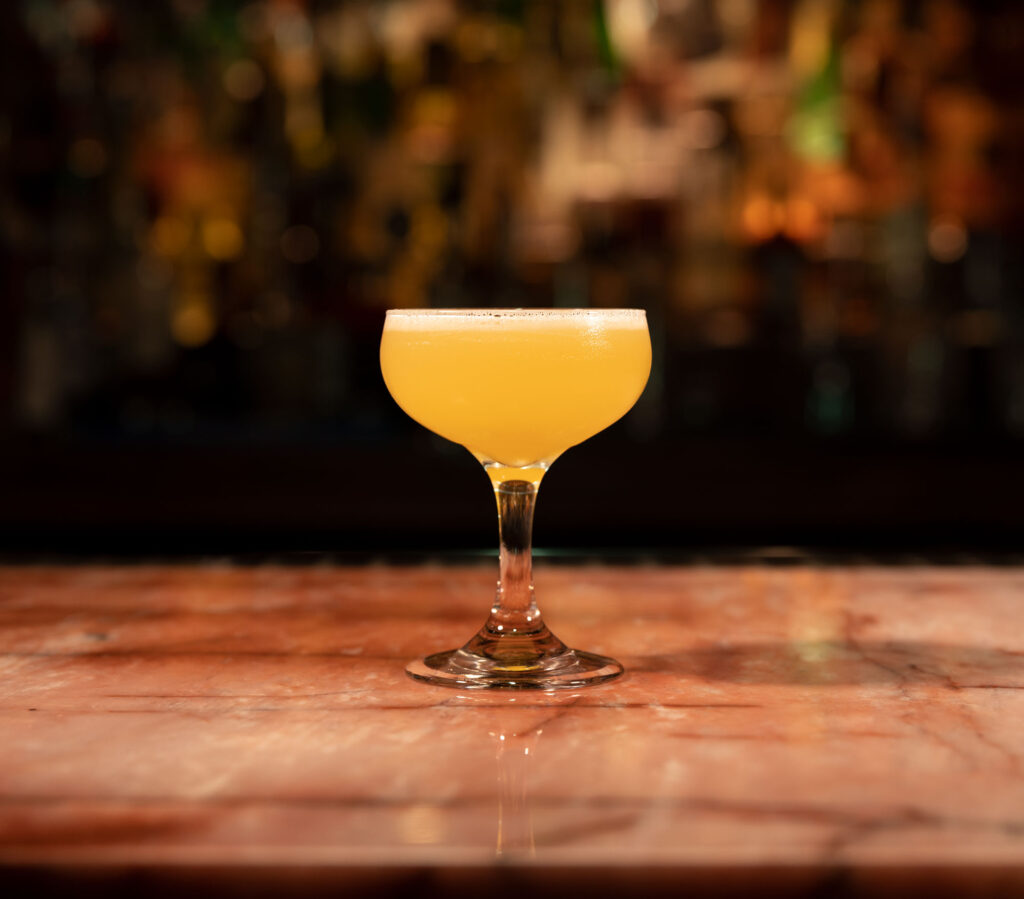
1 dash 20% salt solution
¾ oz lemon oleo-saccharum
1 oz lime juice
2 oz Don Q Cristal Rum
Shake with ice cubes. Fine strain into a coupe.
Starting with Stories
PJ: I like starting with history and stories. Stories sell more cocktails than a description of the taste. I have a lemon oleo-saccharum in here, which is homage to the oldest recipe we have for a Daiquiri, coming from a Mr. Cox down in the Daiquiri mining facility. The original recipe calls for 6 cups of Bacardí Carta Blanca, crushed ice, lemon juice, sugar, and mineral water. So, the original Daiquiri is actually a Collins from what we can find—
Ben: Not to interrupt, but, okay, I will interrupt. It’s documented that Jennings Cox made that drink when he made it, but I don’t think that means it didn’t exist earlier. It makes sense to put those ingredients together, because in Cuba they had all those things. I don’t think he was the first person to do it, even though he was the earliest person whose written account is known.
PJ: Correct. It’s oldest recipe I’ve been able to find. I wanted to use lemon to pay homage to his version. For me, with Don Q Cristal, I get a little bit of lemon peel in the back end as well. I also think salt is a wonderful touch to round out those interesting notes and add a little extra depth to it. So, as I was tasting through and building this, it became an homage to the older recipes in a way that stayed modern and was in balance.
Ben: Do you want to talk about the salt component? This is the only drink we have tonight that has salt in it, but these days, more drinks are using salt solution.
PJ: We talked about the Daiquiri being a baseline cocktail to tell what is good and bad. I referenced the omelet, and if I’m making an omelet I put salt and pepper on it. Whether you’re making a great steak or a great cocktail, sometimes you need a little bit of salt to bring it to that next level. It adds an extra depth and costs essentially zero. It’s the smallest change with the greatest effect.
Santa Teresa Açaí Daiquiri by Ariel E. Neal
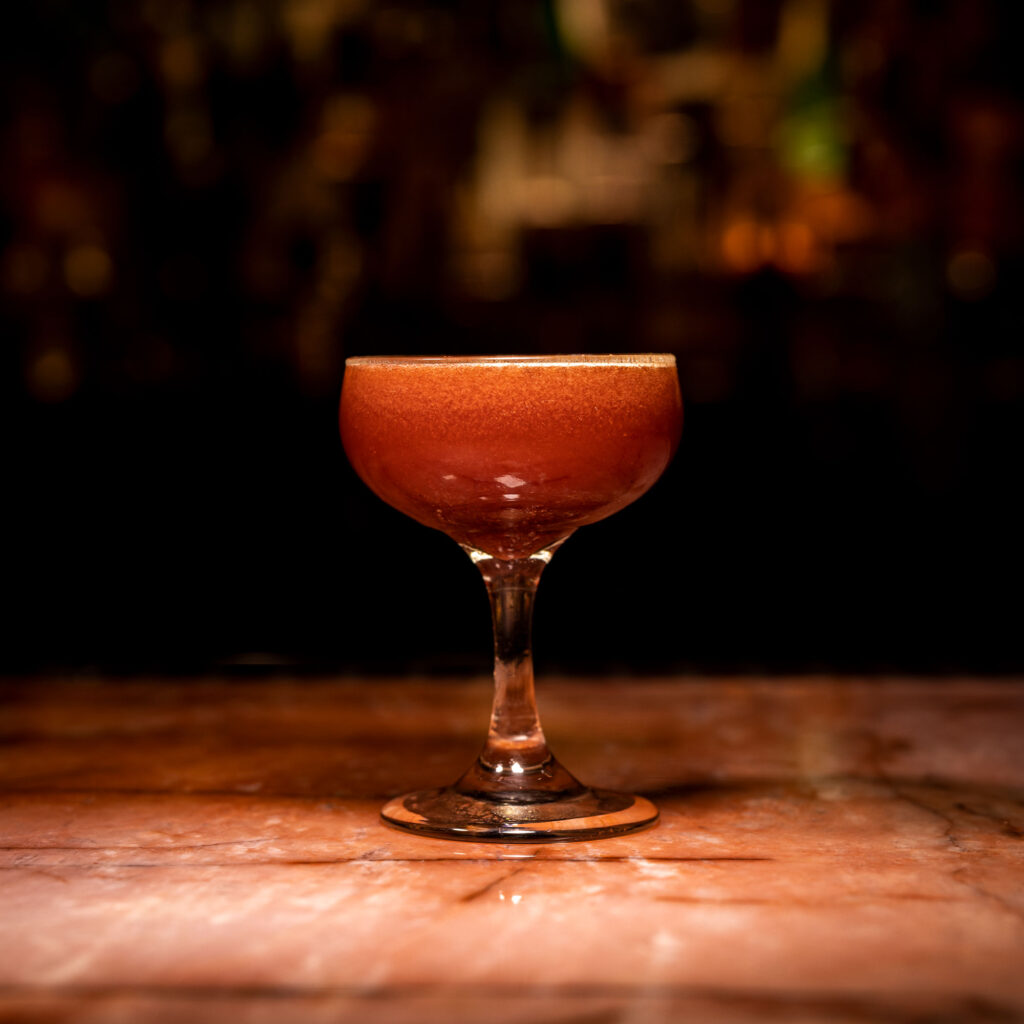
½ oz açaí purée
¾ oz lime juice
½ oz maraschino liqueur
2 oz Santa Teresa 1796 Rum
Shake with ice cubes. Fine strain into a coupe.
Pairing with Food
Ben: Our second drink steps a little bit more into the avant-garde.
Ariel: I love açai. I think the color is amazing. I think the benefits are amazing. I think if you put healthy ingredients in a cocktail, it’s nutritious and delicious. Then you can fight me if you want to, but it is. What I enjoy about açai is freshness. I want people to start playing with flavors—we can do so much more than just lemon and lime. There are other things to consider.
Let’s bring it home and elevate it a little bit. I’m not going to make up any fancy terms—I just like açai. I think it works. I think that you can substitute it for a lot of things.
For me, Santa Teresa stands up in the cocktail. We don’t have to add anything extra. You’re going to get that banana feel. I like that overripe banana and I think that it shines through.
I also believe in making sure that you have balance so that you can continue drinking the cocktail. That’s one of my pet peeves. Even if something tastes good right now for two seconds, five minutes from now, when I come back to it, if it’s disgusting, I don’t want to pay for that. I don’t know if anybody else wants to pay for it. I think that it’s important to be consistent with the cocktail and not have something where it’s only good for one minute. Most people do not slam—I take that back. We do at times. But how we drink with friends should be like when we’re eating. You don’t do all of that in five minutes. It’s a process and I want the process to be long. I want us to be able to talk and you drink, I drink. I have some of yours, you have some of mine. That type of thing.
I think that in the last couple of years we’ve moved from a sweet palate to more of a savory one. Maybe we just grew up and it doesn’t taste the same, but I don’t want the sweet, I want it to balance with whatever I’m eating. Can I have this for dessert? Does it have other opportunities with food? Can I have this with Chinese food? Can I have this with Thai food? I think that’s the kind of playing I want to do with a Daiquiri or any cocktail.
Ben: For this particular drink that you put together, would you see this coming before the meal, with the meal, after the meal?
Ariel: This is an all-the-time drink. Thank you.

Ben: I think it’s important to talk about cocktails with food. People say wine is perfectly suited to food. With cocktails, a little bit more thought has to go into it, right?
Ariel: Okay, but wait, let’s stop. Is it, though? Is wine always suited? If you get somebody who knows exactly what they’re doing, we have a winner. If you get someone to suggest something based on what they think they know and then ask you about your flavor profile, you’re in trouble. With a cocktail, you can change the layers to accommodate the food. Wine is one bottle and whatever they put in there. With a cocktail, I can say, “Cut back on the sugar. Add some saline solution.” You cannot do that with wine.
Ben: In other words, you could tailor the drink to the actual meal, even if someone orders the same drink, you know they’re getting fish or steak or whatever, you could change it up.
Ariel: Yes. You should be asking those questions anyway.
Nigal: Ariel, this drink would be great frozen.
Ariel: You see how Nigal likes to choose violence.
Mount Gay Daiquiri by Dan Smith
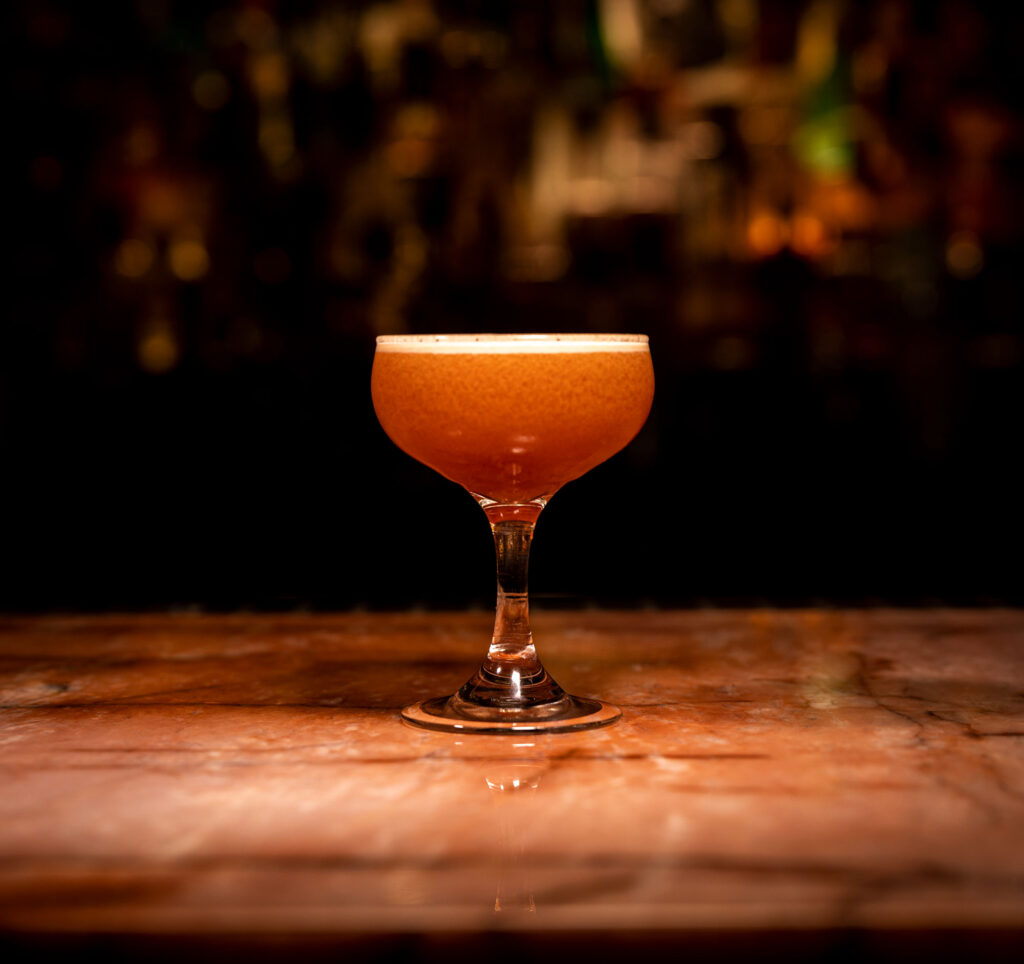
¾ oz simple syrup (1:1), measured just a tiny bit scant
¾ oz Persian lime juice, hand squeezed à la minute using an elbow-style citrus press and fine-strained; or key lime juice, squeezed with your hands, definitely fine strained since here there are seeds, for extra historical authenticity at the expense of some added juicing frustration
2 oz Mount Gay Black Barrel Rum
Shake long and hard with ice cubes. Strain with Hawthorne gate fully closed into a chilled coupe. A Daiquiri should be “severely ungarnished,” as Charles Baker would put it.
Fundamentals
Dan: This one is completely plain. It’s rum, and lime, and sugar. Some of the time in our trade, we are blessed to be able to be creative and to do original things, to combine novel flavors and deploy uncommon techniques with results that are exciting and often delicious. But not all the time. At the core of our trade is a certain set of fundamentals and a large amount of the time what we are doing is responding to a request from a guest, and our goal in that moment is not to use our creativity at all, but simply, using the techniques and fundamentals that we have internalized, to carry out their order as best we can.
A few minutes ago we talked about why the Daiquiri is thought of as the essential bartenders drink—because it’s precisely that. It’s the drink that asks us precisely not to be creative at all but to do nothing other than use all of our fundamentals perfectly and absolutely nothing more. Because this is really rum and lime and sugar. It’s two, three quarters, three quarters, which is the perfect recipe. Yes, limes and sugar differ seasonally and even mass produced rums are subject to some kind of variability. These are things that we respond to on the fly, in the moment when we make the cocktail, with differences of drops.
But the starting point is still the two, three quarters, three quarters that was brought to us by the modern fathers and mothers of our trade, by Audrey Saunders and Sasha Petraske, may he rest, and through Toby Maloney here in Chicago. It’s still the place to start. And, honest to goodness, I don’t believe that will ever change. There’s joy in variety and I’m very happy that it’s possible to riff and toy with that recipe and I love to do it all the time. But ultimately there is one Daiquiri and to my mind that is it.
The one thing that I would note is that Mount Gay Black Barrel is a wonderful aged rum. If one is being strictly traditional about the Daiquiri, it should contain a white rum and light one, a Cuban-style aged and filtered. Mount Gay Black Barrel is not a heavy rum so its profile is a very good fit here, but the color, perhaps, is not absolutely, strictly traditional.

Ben: It’s interesting to me that even though the drink has an aged rum, you didn’t change the specs. That rum was able to slot in even though it has different characteristics.
Dan: The only thing that would change the perspective would be if the proof differed a lot. With an overproof rum, it would need a little more sugar.
Another thought in connection with a Daiquiri as plain as this, is that I have an unorthodox position on what the Daiquiri means for us here in Chicago, in a deeply un-tropical climate. I don’t think it’s an escape. In fact, I don’t think it’s a specifically tropical drink at all. Historically, it emerges exactly at the intersection between American cocktail culture and the Cuban spirits industry. And a pillar of our culture in Chicago is our specific architecture which looks different from that of any other city. Its greatest hero is Mies van der Rohe, the father of aesthetic modernism and of purism and minimalism. And the Daiquiri—rum, lime, and sugar, shaken, strained, and served straight up with no crushed ice and no garnishes—is the Mies van der Rohe of cocktails. It’s the most minimalist and modernist of cocktails, and it’s absolutely at home in Chicago.
PJ: I think it’s interesting you specified straining with a closed gate versus using a mesh strainer.
Dan: Right. It’s got to have some texture. The mesh strainer knocks down the aeration too much for me and makes it too flat. So, it’s a matter of compromise there, I think.
Katie: The only reason that I fine strained my Daiquiri was because the spices don’t dissolve completely. On a regular Daiquiri, I use a fully closed gate, and I don’t fine strain.
Dan: Also, the lack of garnish is also an aesthetic choice. It’s not the absence of making the cocktail nice. It is a way of saying, “I have chosen to present this just as it is.” I’m not saying all the time. I love a lavish garnish, but that’s a decision that you make.
A garnish can complement a dink, and add aroma, of course. Even if it’s just for looks, even if it’s just decorative, seeing the cocktail is a part of consuming. You drink first with your eyes. However, a lavishly garnished drink isn’t the only way to go. It strikes me that there is a beauty and a purity in simple minimalism. With an ungarnished drink, you see it and you think, “Oh, what is there here? I see nothing. I see a pale color. I see an unadorned glass.” It forces you to look for what there is, which is balance and delicacy of flavor.
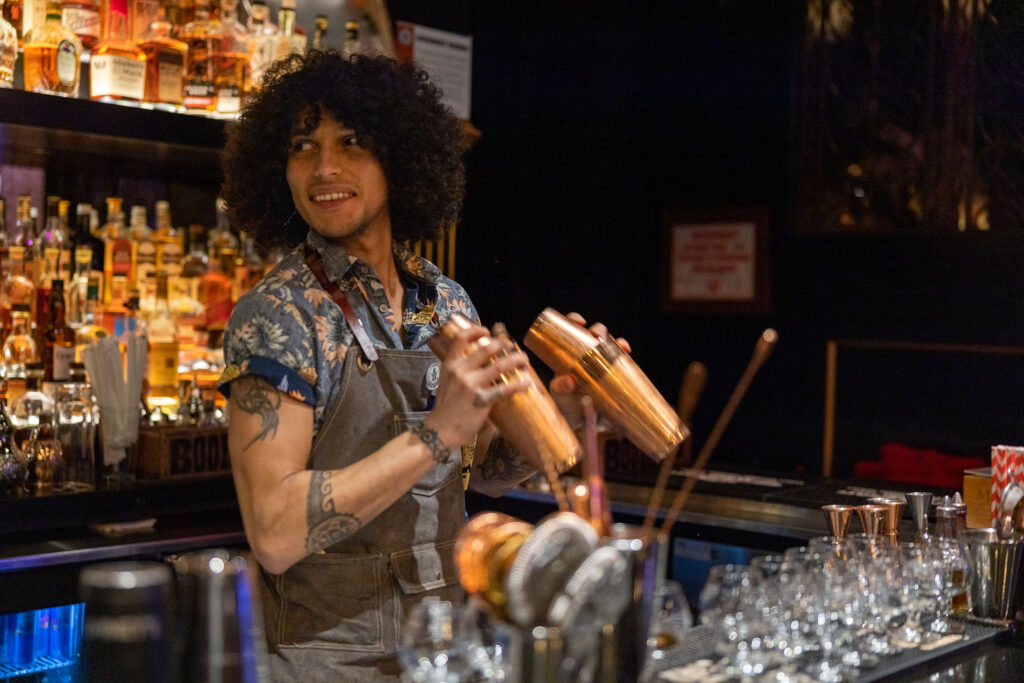
Acid
Dan: I wrote a lot of technique because this drink is all technique and no recipe, to my way of thinking about it. But the reason for hand squeezing the lime, specifically with the elbow press or the standup press juicer, is the same reason that PJ has included oleo-saccharum, which is that when you use the elbow press, in addition to expressing the juice from the lime, it also crushes the peel and expresses all the fragrant essential oil, which then immediately becomes part of the flavor of the cocktail. It dramatically increases the limeness.
Working with them is a big pain in the neck because they’re so small, but I especially like key limes, which at the time the Daiquiri emerged in Cuba would’ve been the one because the Persian lime wasn’t widely available for another eight or nine years. Key limes have about the same acid levels as Persian in the juice, but the peel has a much cleaner, less bitter, lighter flavor. So it makes really magnificent Daiquiri when you get some.
PJ: The key lime has significantly more oil. If you’ve never peeled the two side by side, it’s a fun experiment, because you’ll immediately see and feel the difference.
Katie: I would like to know how the panel feels about alternative acids. At home, I usually make a citrus stock, because limes have been so bad recently. Splitting the lime juice with citric and malic acids.
Ariel: I’m a fan because anybody who buys cases of limes know that they’re $450 right now. So there’s that.
Nigal: I’ve worked on projects where you get a case of limes and use every bit of it. We’re making an oleo, making a solution with the peels, we’re juicing, and then we’re taking the rinds and we’re making a stock of out that. And we’re adjusting that into different acid solutions. If your bar wants to be more sustainable, I think that’s perfect. But side by side I’m always going to choose the pure citrus versus any solution. So when I was running the bar program, I would use the solution more as a way to sell a happy hour punch. I’m not happy if you pay the same amount for an acid-corrected solution as you would with the pure juice.
Katie: If it allows you the freedom to make more of these things more authentically for pennies instead of dollars—everyone’s bars are being squeezed right now on margins—finding other ways that we can continue practicing is important. If I can take that money out of my citrus and put it into something else that continues to add flavor to a drink, then that’s all for the better.
Bacardí Reserva Ocho Daiquiri by PJ Wagner
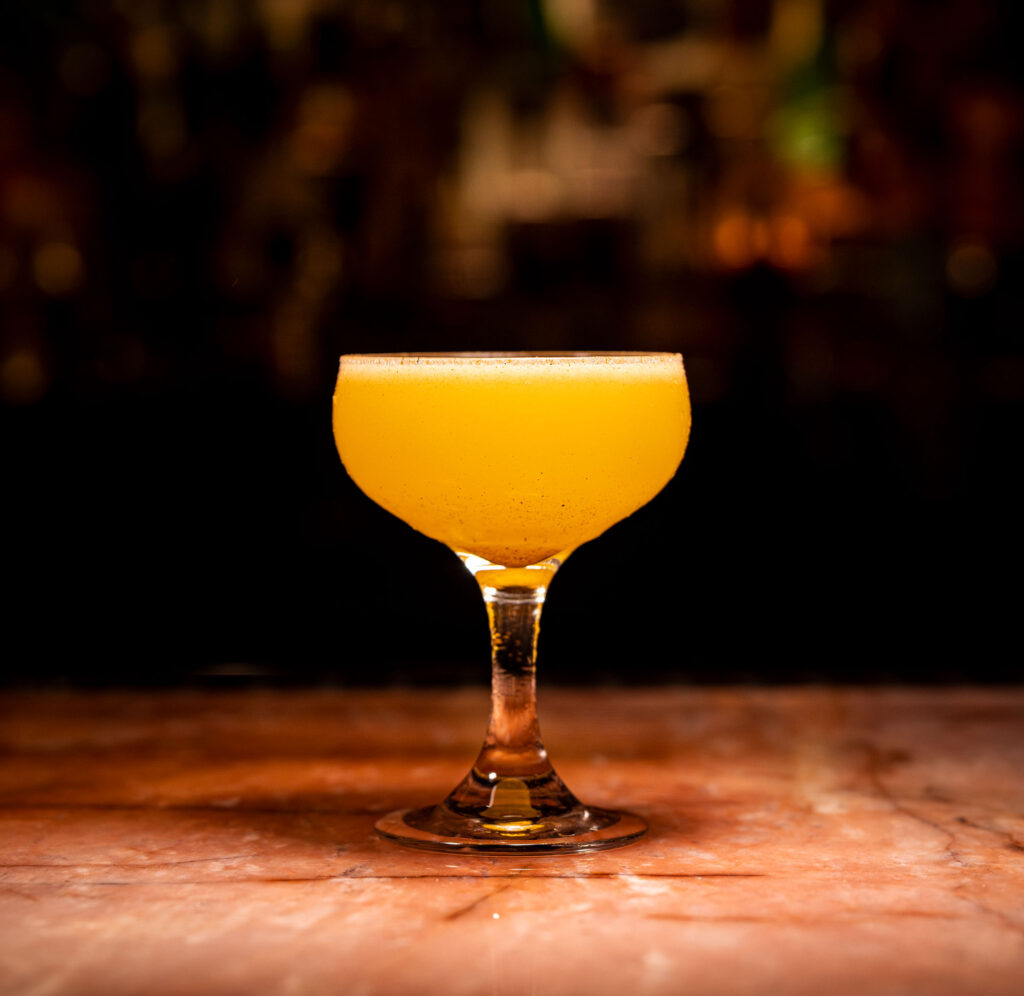
3 dashes Angostura aromatic bitters
¾ oz strawberry syrup
½ oz pineapple juice
½ oz lime juice
2 oz Bacardí Reserva Ocho Rum
Shake with ice cubes. Fine strain into a coupe.
Nostalgia
Ben: PJ, you’re the only person on the panel that we asked to make two drinks. Do you want to talk about your process for creating two distinct Daiquiris?
PJ: With my first drink, I wanted to pay homage to the origin story of the Daiquiri. With this one, I wanted to make a room full of Chicago bartenders drink a Strawberry Daiquiri and like it. We have these opinions of drinks that were around before most of us were even bartending or anywhere near old enough to drink. The Strawberry Daiquiri swept the entire nation in the 1960s and ’70s. Many people in the world, when they think Daiquiri, they think Strawberry Daiquiri. They think of it as frozen. They think of it with lots of bad juice or no juice at all. I have to ask, “Why was this popular if we know it’s bad?” It’s because something in its core has to be good. There’s something there that’s why it’s stuck around.
It’s a classic, for better or worse. I think there are a lot of these. I call them “dive bar classics.” Things like the White Russian, the Kamikaze. There’s got to be a reason why they’re still around, because if they were just bad, no one would ever drink them.
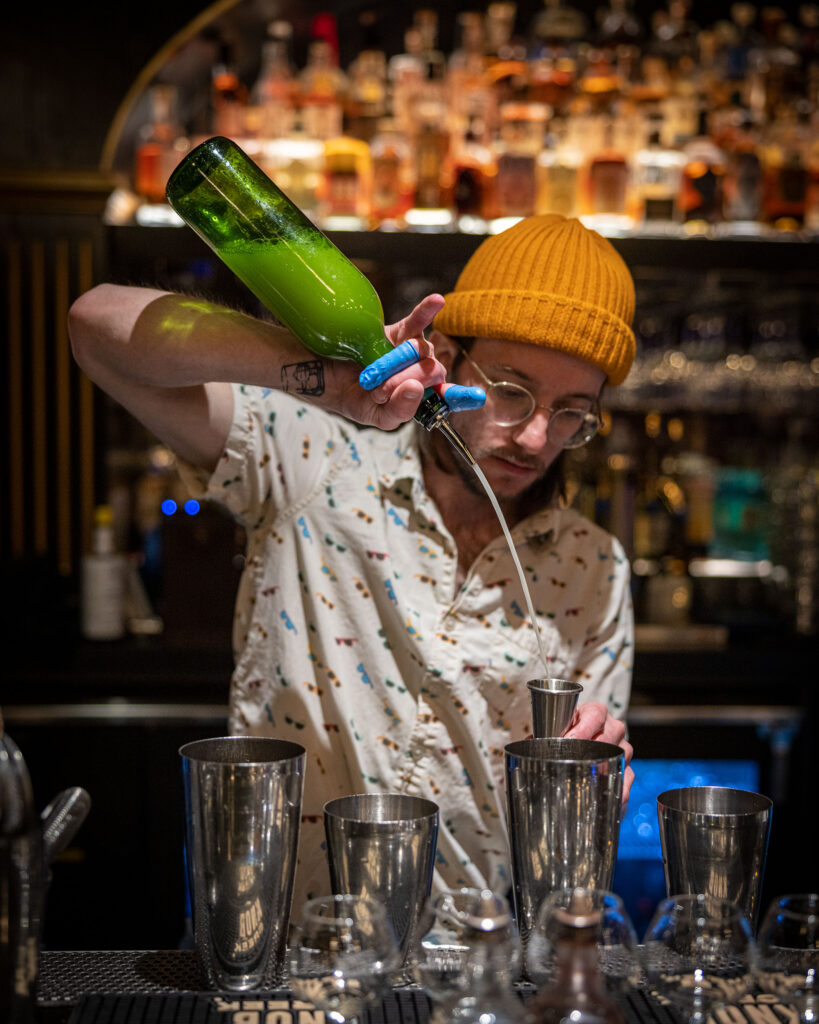
Ariel: I agree with it up to a point. Food and drinks are nostalgic. I my mom had it, my dad had it, it was in the house. It doesn’t have to be good, it’s what I remember. It’s the smell. It’s how I felt when I drank it. Most people have had SpaghettiOs. SpaghettiOs are gross as hell. However, if someone served you SpaghettiOs, you get this feeling, “Oh, my childhood. Oh, the babysitter.” Peanut butter and jelly, same thing. It’s not great. It’s a nostalgia. It’s how you felt when you tasted these things before.
Somebody had to actually tell you this was not good. And then you tried something better and you’re like, “What was I doing all this time?” That’s where I believe we get these bad drinks from. We’ve still got people drinking all types of stuff where you’re like, “Why would you ever put these things in a glass?” Because it’s nostalgic for them, it’s what they know.
Ben: I’m just jealous that you grew up in a family that had Strawberry Daiquiris in your childhood.
PJ: I think that there is that beauty in that nostalgia. There are the memories, the thoughts of it that we remember and we crave. It’s not necessarily the actual item itself. I wanted to take those ideas—but also I think strawberry and citrus and rum taste good together.
Ariel: They do.
PJ: The Bacardí Ocho has some interesting dark barrel spice notes that come through. I wanted to pair that with the Angostura bitters, and then round it out with strawberry, pineapple, lime, using each one to balance the next. We talked about acid adjusting. You don’t necessarily have to add acid. Maybe you can add a different citrus. And that was the plan here by splitting the lime with the pineapple and then rounding that out with strawberry for sweetness.
Denizen & Luxardo Hemingway Daiquiri by Nigal Vann
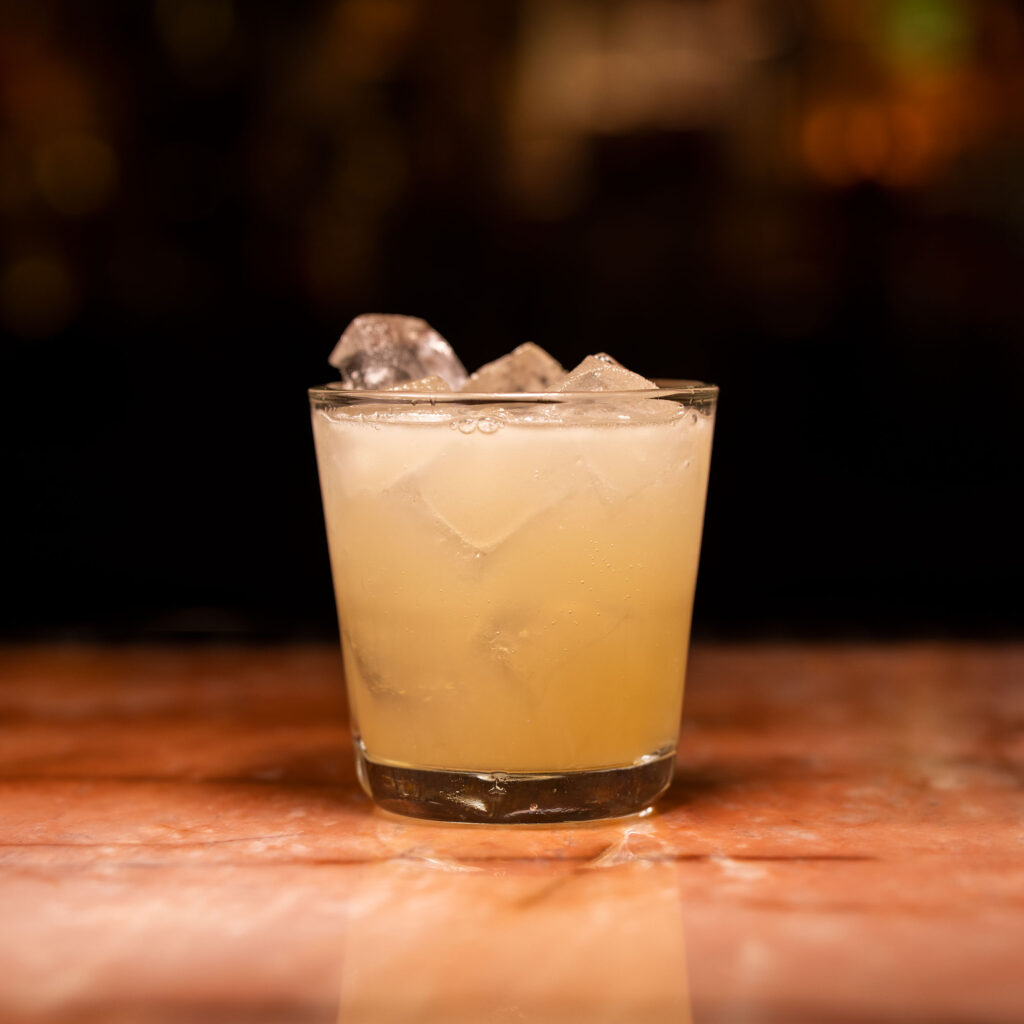
2 dashes lavender bitters
¼ oz Demerara syrup (2:1)
½ oz grapefruit juice
¾ oz lime juice
½ oz Luxardo Maraschino Liqueur
2 oz Denizen Aged White Rum
Shake with ice cubes. Fine strain into an Old Fashioned glass filled with ice cubes.
Hemingway, Ribalaigua, DeGroff
Ben: We have already alluded to the next drink. As we said, Mr. Hemingway’s choices are his own, but today most of us know Constantino’s Daiquiri No. 3 as a Hemingway Daiquiri. The most common version is the one Dale DeGroff introduced at the Rainbow Room. He also was the first to give it the Hemingway Daiquiri name. But Nigal has his own delicious take on it.

Nigal: If you see cocktail development as an art or a science, I tend to lean more on the art side. I get inspired more by the origin story rather than following the original specs. Maybe some people might disagree and say the spec is what the drink is. But I’m also in this experience as a hospitality worker, so I like to create things that customers are looking for. We have a menu, but we create cocktails. You come to me, you say what you want, your spirit, your flavor profile, and then we’ll make up something for you. I’m in it for my guests.
So if my guests come to me and say, “I want an Old Fashioned, but I want you to use Denizen White rum. And I want a bit of cane sugar and add some lime juice to it and shake it up,” I’m not going to criticize it. I’m not the one drinking it, I’m making it for you to enjoy.
With maraschino, of course, you get that cherry note, and I thought that cherry goes with grapefruit, which is already in the classic Hemingway. But I upped that by adding a bit of lavender. Making it light, refreshing, true to the original cocktail, but also giving it a fun twist, but not too far where you wouldn’t consider it to be a Daiquiri.
Denizen has a great body to it. It has a slight vanilla note. It takes whatever I have and just makes everything expand. A drink isn’t just its flavor, it’s also about the body. It’s that texture, how it feels against my tongue, how it feels against my cheeks. And so adding that quarter ounce of Demerara, two to one, gives me the body that I need. Texture is just as important as the actual flavor.
Katie: I wonder about these ice cubes.
Nigal: It slows it down. Without the ice cubes in there, I’d just shoot it right now. This is for me to slow down and enjoy it. Also, the strength is there, so the ice adds some needed dilution. The flavor does change over time. If you let it sit a little bit longer, things will happen.
Ben: I don’t think anyone’s letting it sit….
Nigal: Yeah, it should be good enough that in five minutes, the drink’s not there anymore. But if it was a larger format and you were drinking it, it would still be great with the extra dilution from the ice. It keeps it chill. As I’m talking with my friends, it could warm up. So the ice is there for multiple reasons.
Ariel: So you’re not trying to control us.
Ben: I thought maybe the extra dilution was kind of like a spit in the eye of Hemingway, who wanted the least dilute, booziest drink he could possibly get.
Nigal: I’m not here to say yes. No comment.
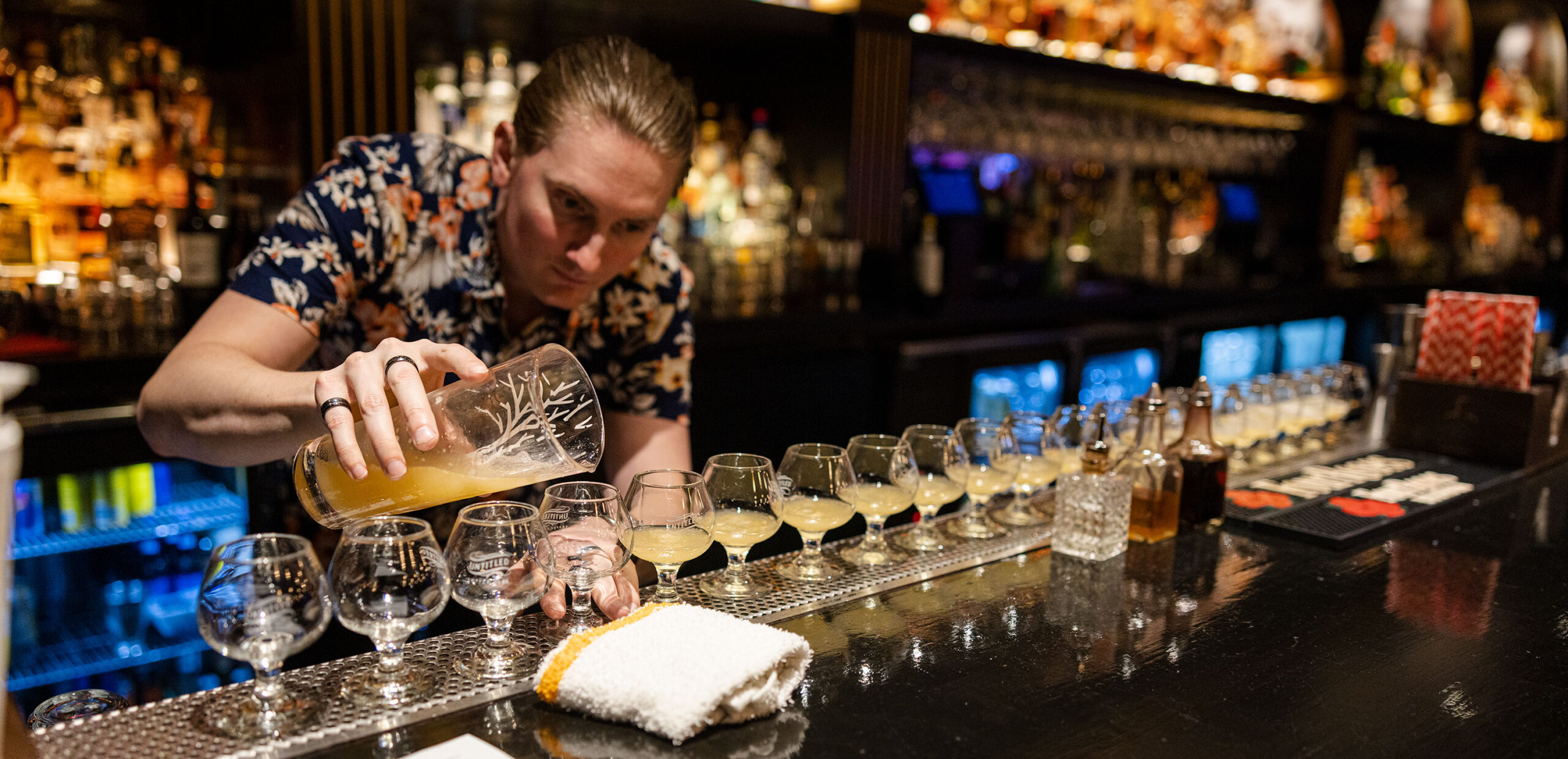
Ariel: But you know, the problem with that is you have to take care of people if you’re going to serve them a very boozy drink. That’s not my role anymore. You’re going to get what I need to give you for hospitality reasons only. And you’re going to drink how I want to serve it to you.
Ben: So if Ernest Hemingway comes into your bar asking for a Papa Doble, is he getting 86’d?
Ariel: I would say, “Here at Casa De Liera, you will get this how I serve it because I’m not babysitting you, Hemingway.”
When people say, “Give me the strongest drink,” I go, “Are you sure?” And I give them the weakest shit available, because saying that means you’re going to make my life horrible. That means you came for a purpose and you’re trying to ruin me.
Ben: A related thing is the people who say, “Don’t put sugar in it, I don’t like it too sweet.”
Dan: We need to educate the public on what balance is. Sweetness isn’t the same thing as the presence of sugar. Sweetness is the presence of sugar without enough of a counterbalancing ingredient.
Wray & Nephew Tamarind Jerk Daiquiri by Katie Vota
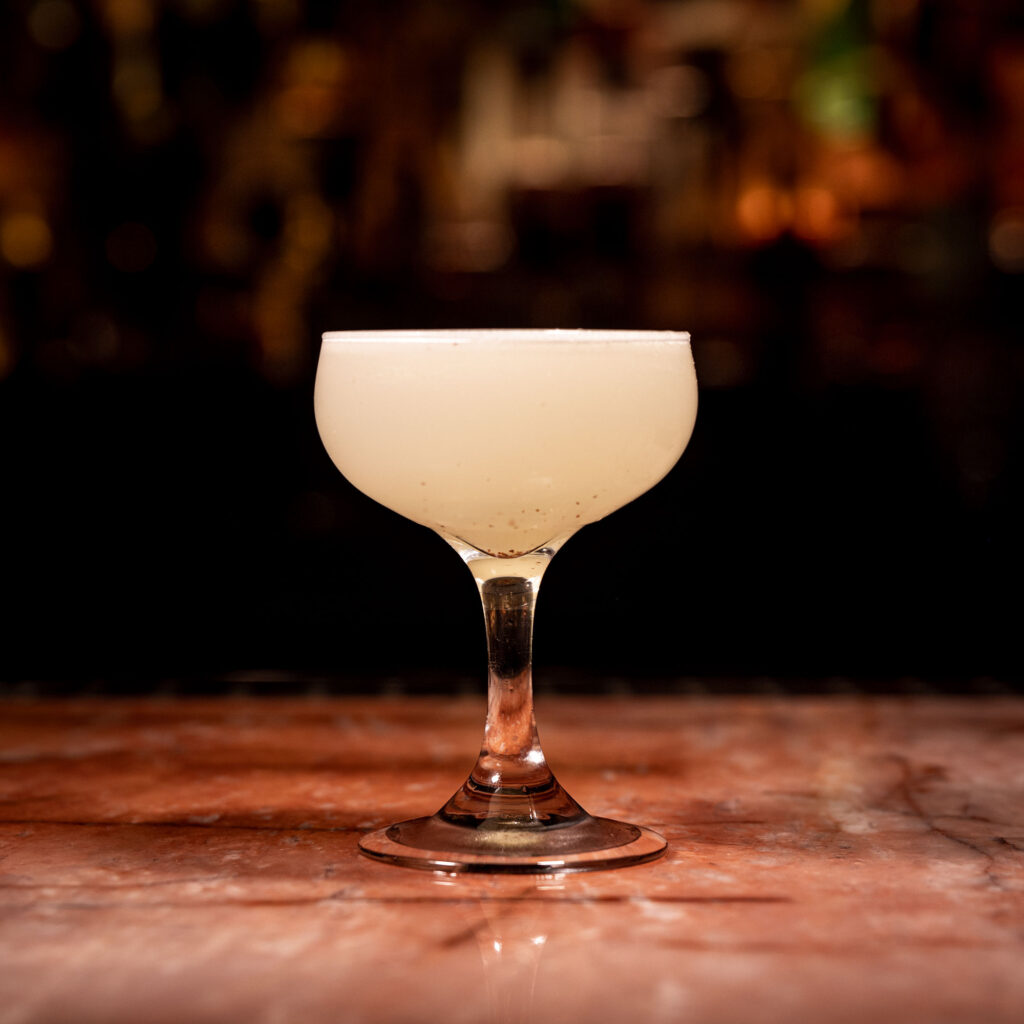
¼ oz simple syrup (1:1)
1 oz tamarind jerk syrup (see below)
1 oz lime juice
2 oz Wray & Nephew Overproof Rum
Shake with ice cubes. Fine strain into a coupe.
Tamarind Jerk Syrup
16 oz water
12 oz Demerara sugar
4 oz Tamicon tamarind concentrate
2 tsp jerk spice blend (see below)
Heat the water in a saucepan until boiling. Reduce heat to medium and add the spice blend and Demerara, stirring until dissolved. Turn off the heat, then add tamarind concentrate and stir until dissolved. Bottle and refrigerate.
Jerk Spice Blend
(Makes about 2 Tbsp, or enough for 3 batches of jerk syrup)
1¾ tsp ground thyme
1 tsp fine ground black pepper
1 tsp ground allspice
½ tsp sweet paprika
½ tsp ground cinnamon
¼ tsp ground nutmeg
¼ tsp ground cayenne
¼ tsp kosher salt
The Big Finale
Ben: We’re working our way up to a rather showy finale, because Katie has made a tour de force. She went all the way with the concept of making a Jamaican version of the Daiquiri by incorporating Jamaican culinary traditions too. Katie, let’s hear about your brain and how this all came about.

Katie: The rum that you gave me was quite the tour de force on its own.
The first thing I did was try to make a classic Daiquiri with the Wray and Nephew. And my partner took one sip, and was just like, “You’re going to have to finish this.” If you guys aren’t familiar with Wray and Nephew, it’s an overproof, extremely funky, unaged rum. The syrup needed a lot of backbone to stand up to those flavors. PJ’s drink is not the only one with salt in it. My jerk spice has salt because I agree that salt really gives a drink that depth and balance—and that was quite required for a drink like this.
My original concept for this drink was based on research I had been doing for a friend’s dinner party that I did cocktails for. She’s Thai and had smuggled back some Thai moonshine called lao khao. She said, “I can’t get this in the U.S. It’s not legal to distribute it here. What would you do if you could make cocktails with this?” I came up with a list of mostly rhums agricoles in order to try to approximate the flavors of the lao khao, but Wray and Nephew was also on the list. And tamarind, while it came to Jamaica in the 1600s, is also very prevalent in Southeast Asia, so my first thought was to bring tamarind into this drink to complement some of those green flavors.
But instead of continuing in a Southeast Asian direction where maybe you add lime leaf or basil or something like that, I wanted to make it more Jamaican. So I incorporated the jerk spice into it. For the jerk spice for this drink, I turned the Alliums down quite a bit, as adding garlic to your cocktail is not a super big hit. It’s spiced, but not spicy, in its conception.
Ben: It reminds me of a Don the Beachcomber kind of approach. Because he would go with the spices.
Katie: Exactly. It very much starts to go in that direction. For the tamarind, I don’t usually use fresh tamarinds. The concentrate’s about as close as you can get to fresh tamarind without actually having to peel and pith it yourself. If you’ve used date molasses, it has that consistency and texture.
Ariel: This is a cocktail like I was talking about before. It has a lot of going on. The flavor is going to be great ten minutes from now, twenty minutes from now. It probably won’t last that long, but it’s still going to be great. And then I want it with food.
Ben: It’s got a real culinary connection. In the heyday of Don the Beachcomber and Trader Vic’s, you’d have tropical drinks next to spicy food. But here we’re having the spiciness in the drink, which I think is something that tropical drinks didn’t explore historically. But I think it’s really interesting to explore now.
Edifying Hospitality
Ariel: I have a closing thought.
You should absolutely have a drink however way you want. But in the hospitality industry, we are here to educate our guests. I think that you should teach and educate your guests how not to have a sweet, frozen Daiquiri. Hold on. It costs more, right? You almost have to make the rum stand up in the cocktail. And then you’re adding all of this shitty ice. So if you teach them to drink properly, you can save on product costs. You can save on efficiency and you can get one person to do the whole thing, and the drink is better besides. That’s it. I am complete.
PJ: I think that it’s a very brilliant point to talk about education, especially from the clientele side. We often talk about attending events and panels like this to educate ourselves and educate our staff, but when was the last time you had a guest training, right?
Dan: Every day.
PJ: But often we end up saying, “You know what, I could make more money if I talk less and make drinks faster.” And, yeah, maybe you can. But over time you have to look at the effect that it has not only on your bar, but the bars around you and the general drinking experience of the clientele.
Dan: Because if all we wanted to do was make money, we wouldn’t be in the cocktail sector.
PJ: Exactly. We’re doing what we love. And we’re creating something that we’re passionate about and having that moment to share the passion and show a little bit of the why. Maybe give the guest the moment to experience things in a new way.
Nigal: I’m conflicted on this. Like I said, I’m here for the people, so I’ll give you what you want. If you want a Frozen Daiquiri, if I’m able to, I’ll make you a Frozen Daiquiri that has all the sugars of the world.
As a bartender, as a hospitality worker, I like to know specs, stories, where it came from and then play around with where it could go. So if you came in and said, “I want the David Wondrich version of the Daiquiri,” that’s what you’re going to get. I know my recipes, but I also like to be creative. Again, I’m more artist than scientist. I’m like, “If you like that, maybe you should try this.” I like to educate my guest in a fun way. If you come to my bar, and you don’t know, I’m going to slide it in. I’m not going to outright teach you.
I want you to enjoy your experience, whatever that may be. So that’s why I say I’m a bartender, not a mixologist. I’m here to have you at my bar, make a connection. I want you to come back, tell your friends about it. And I think what’s in the glass is kind of just a byproduct.
But Daiquiris are amazing.
Katie: You want what you want. That’s not my business, but I’ll tell you what I think. And I’ll be like, “Ooh, but also, what about this?” And that’s the fun part of this, right? That interaction with the guest, those connections that you make, those little bits of information. And all of a sudden, you have shifted someone’s opinion entirely with a classic Daiquiri that they never expected to like because what they thought the Daiquiri was is not what it is. And that beautiful epiphany for a guest is what it’s all about.
Ben: Well, that’s a perfect closing. We started talking about recipes, we ended up talking about hospitality. The Daiquiri delivers on both counts. Thank you, everyone.
